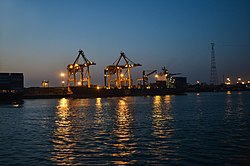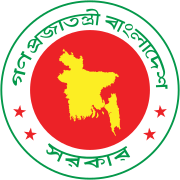
Feni is a coastal district situated in the south-east of Bangladesh, within the Chittagong Division. One of Bangladesh's smallest districts, it is strategically located along the Dhaka–Chittagong transportation corridor. Bordered by India to the north and the Bay of Bengal to the south, it serves as the sole entry point linking Chittagong, the country's primary port city, to the northern districts.
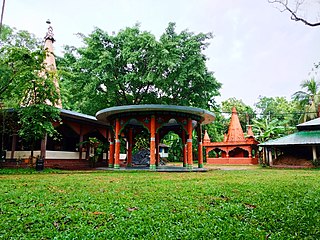
Chandanaish is an upazila of Chattogram District in Chattogram Division, Bangladesh.
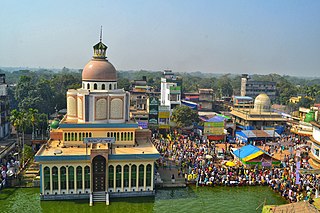
Fatikchari(Bengali: ফটিকছড়ি, romanized: Fôṭikchhôṛi) is an upazila of Chittagong District in Chittagong Division, Bangladesh. It is the largest Upazila of Chittagong.

Hathazari is an upazila of Chattogram District in Chattogram Division, Bangladesh.

Lohagara is an upazila of Chattogram District in Chattogram Division, Bangladesh. Lohagara is situated between Chattogram and Cox's Bazar. It is one of the largest and most densely populated upazilas of Bangladesh. It has headquarters in Lohagara.

Mirsharai Upazila is an upazila of Chattogram District in Chattogram Division, Bangladesh. It comprises two police stations and two municipalities.

Raozan Upazila is an upazila of Chattogram District, in Chattogram Division, Bangladesh. It was established in August,1947.

Sandwip is an upazila of Chattogram District in Chattogram Division, Bangladesh. It encompasses the islands of Sandwip and Urir Char.

Satkania is an upazila of Chattogram District in Chattogram Division, Bangladesh.

Sitakunda is an upazila in the Chattogram District of Chattogram Division, Bangladesh. It includes one urban settlement, the Sitakunda Town, and 10 unions. Sitakunda is the home of the country's first eco-park, as well as alternative energy projects, specifically wind energy and geothermal power.

Companiganj is an upazila of Noakhali District. Basurhat is the only municipality in this upazila. The area is famed for water buffalo doi (curd).

Halda River is a river in south-eastern Bangladesh. It originates at the Badnatali Hill Ranges in Ramgarh Upazila in the Chittagong Hill Tracts, flows through Fatikchhari Upazila, Bhujpur Thana, Hathazari Upazila, Raozan Upazila and Chandgaon Thana of the Chittagong Metropolitan City, and falls into the Karnaphuli River. The 81-kilometre-long (50 mi) river has a very turbulent tributary, the Dhurung River, which joins Purba Dhalai about 48 kilometres (30 mi) downstream. The river is navigable by big boats 29 km (18 mi) from its mouth up to Nazir Hat, and by small boats 16–24 kilometres (9.9–14.9 mi) further up to Narayanhat. The Halda averages 21 feet (6.4 m) in depth and is 30 feet (9.1 m) at its deepest point.
Suabil Union is a union of Bhujpur Thana of Chittagong District.

The Sangu River is a river in Myanmar and Bangladesh. Its source is in the North Arakan Hills of Myanmar, located at 21°13´N 92°37´E. The Arakan Hills form the boundary between Arakan and the Chittagong Hill Tracts. It follows a northerly circuitous course in the hill tracts and then enters Bangladesh near Remaikri, Thanchi Upazila, Bandarban District, from the east. It flows north through Thanchi, Rowangchhari and Bandarban Sadar Upazilas of Bandarban district. It then flows west through Satkania and Banshkhali Upazilas in Chittagong district and flows into the Bay of Bengal near Chittagong, at 22°6´N 91°51´E, or about 16.09 kilometres (10.00 mi) south of the mouth of the Karnafuli River. The length of the river is 270 kilometres (170 mi) of which 173 kilometres (107 mi) are located within Bangladesh.
The N1 or Dhaka–Chittagong Highway is the main transportation artery of Bangladesh, connecting the capital city of Dhaka and the southern port city of Chittagong. Approximately 465 kilometres in length, the highway starts at Jatrabari in Dhaka and ends at Teknaf in Cox's Bazar. The highway is known along certain stretches as the Chittagong–Cox's Bazar Highway and the Cox's Bazar–Teknaf Highway.
Betagi is a Union Council of Rangunia Upazila in Chittagong District, Chittagong Division, Bangladesh.

Chittagong-13 is a constituency represented in the Jatiya Sangsad of Bangladesh since 2014 by Saifuzzaman Chowdhury of the Awami League.
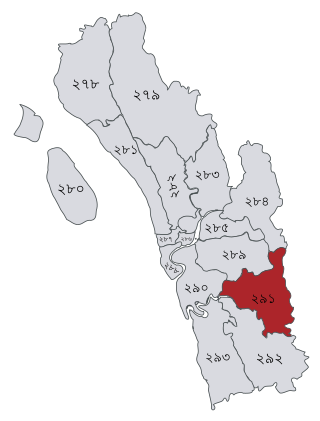
Chittagong-14 is a constituency represented in the Jatiya Sangsad of Bangladesh since 2014 by Nazrul Islam Chowdhury of the Awami League.

The Greater Noakhali region predominantly includes the districts of Noakhali, Feni and Lakshmipur in Bangladesh, though it has historically also included Bhola, Sandwip and some southern parts of Tripura in India and southern Comilla. The history of the Noakhali region begins with the existence of civilisation in the villages of Shilua and Bhulua. Bhulua became a focal point during the Buddhist and Hindu kingdoms of Pundra, Harikela and Samatata leading it to become the initial name of the region as a whole. The medieval Kingdom of Bhulua enjoyed autonomy under the Twipra Kingdom and Bengal Sultanate before being conquered by the Mughal Empire. At the beginning of the 17th century, Portuguese pirates led by Sebastian Gonzales took control of the ara but were later defeated by Governor Shaista Khan. Affected by floodwaters, the capital of the region was swiftly moved to a new place known as Noakhali, from which the region presently takes its name. By 1756, the British East India Company had dominated and started to establish several factories in the region. The headquarters was once again moved in 1951, to Maijdee, as a result of Noakhali town vanishing due to fluvial erosion.





